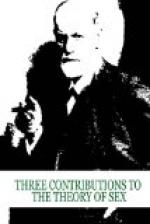To complete the picture of the infantile sexual life one must add that frequently or regularly an object selection takes place even in childhood which is as characteristic as the one we have represented for the phase of development of puberty. This object selection proceeds in such a manner that all the sexual strivings proceed in the direction of one person in whom they wish to attain their aim. This is then the nearest approach to the definitive formation of the sexual life after puberty, that is possible in childhood. It differs from the latter only in the fact that the collection of the partial impulses and their subordination to the primacy of the genitals is very imperfectly or not at all accomplished in childhood. The establishment of this primacy in the service of propagation is therefore the last phase through which the sexual organization passes.
The Two Periods of Object Selection.—That the object selection takes place in two periods, or in two shifts, can be spoken of as a typical occurrence. The first shift has its origin between the age of three and five years, and is brought to a stop or to retrogression by the latency period; it is characterized by the infantile nature of its sexual aims. The second shift starts with puberty and determines the definitive formation of the sexual life.
The fact of the double object selection which is essentially due to the effect of the latency period, becomes most significant for the disturbance of this terminal state. The results of the infantile object selection reach into the later period; they are either preserved as such or are even refreshed at the time of puberty. But due to the development of the repression which takes place between the two phases they turn out as unutilizable. The sexual aims have become softened and now represent what we can designate as the tender streams of the sexual life. Only psychoanalytic investigation can demonstrate that behind this tenderness, such as honoring and esteeming, there is concealed the old sexual strivings of the infantile partial impulses which have now become useless. The object selection of the pubescent period must renounce the infantile objects and begin anew as a sensuous stream. The fact that the two streams do not meet often enough has as a result that one of the ideals of the sexual life, namely, the union of all desires in one object, can not be attained.
THE SOURCES OF THE INFANTILE SEXUALITY
In our effort to follow up the origins of the sexual impulse, we have thus far found that the sexual excitement originates (a) as an imitation of a gratification which has been experienced in conjunction with other organic processes; (b) through the appropriate peripheral stimulation of erogenous zones; (c) and as an expression of some “impulse,” like the looking and cruelty impulses, the origin of which we do not yet fully understand. The




